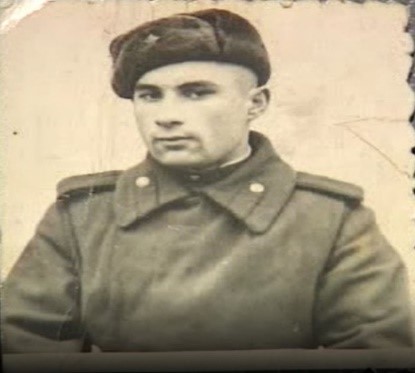Efim Charnis was born in 1924 in the village of Dyakivtsi, some thirty kilometers northwest of Vinnytsia in southwestern Ukraine, where his father Srul (Yisrael) owned a straw cutter and a grain grinder. In 1929, the Soviet authorities classified Srul Charnis as a kulak (affluent peasant) and expropriated him, nationalizing his businesses. The family moved to Brayiliv, a township south of Dyakivtsi, where Srul worked as a tractor driver, and later as a flour miller. His mother Hannah worked as a milkmaid in the town. Efim finished a Ukrainian school.
In June 1941, the Soviet-German War broke out. Efim's father Srul was drafted into the Red Army, while Efim and his mother failed to evacuate and found themselves under German occupation. In July 1941, they were incarcerated in the Brayiliv Ghetto. Efim survived four "selections" and massacres of Jews, which were carried out by the Germans from February to June 1942. That June, Efim and his mother fled into Romanian-occupied territory (Brayiliv was close to the demarcation line between the German and the Romanian occupation zones), and they spent some time in the Zhmerinka Ghetto. In September 1943, the Romanians and the Germans arranged for a return of the Jewish refugees in Zhmerinka to Brayiliv. Efim managed to escape from the column of "returnees" and came back to Zhmerinka; his mother was killed in the escape attempt.
As a precaution, the Jewish council of the Zhmerinka Ghetto transferred Efim to the ghetto in Voroshilovka, which was located on the right, western bank of the Southern Bug River. In March 1944, the inmates of the Voroshilovka Ghetto learned that the Red Army had reached the left, eastern bank of the Southern Bug. Efim swam across the river, approached the Red Army positions, and asked to join the unit as a regular soldier. The Soviets agreed, and several days later he took part in the liberation of Zhmerinka. Afterward, he was ordered to show up at the local recruitment office, to be formally enlisted. This was the beginning of Charnis's regular military service.
At first, Charnis was assigned to an infantry unit. However, he quickly realized that quite a few of his comrades-in-arms were former Ukrainian policemen, who had served the Germans and the Romanians during the occupation, and later joined the Red Army in an attempt to wash off the stain of collaboration with the enemy. Hence, the atmosphere in that infantry unit was rather antisemitic. Charnis complained about this to his commanders, and was transferred to the reconnaissance group of the Separate Motorcycle Battalion of the 11th Guards Tank Corps. He served with this battalion until the end of the war, seeing action in Poland and Germany.
Efim Charnis was awarded two military orders: the Order of Glory, 3rd class, and the Order of the Red Star. The citation for his Order of Glory says: "Comr[ade] Charnis, serving in the reconnaissance group, proved himself a courageous scout. On January 1, 1945, while being part of a forward patrol [golovnoi dozor] in the area of Rossocha [east of Łódź, Poland], he came under machine gun fire from an ambush, which impeded the progress of the forward patrol. Comr[ade] Charnis was ordered to eliminate the ambush, using an armored personnel carrier. With a valiant push, he broke through into the enemy position. Using hand grenades and a machine gun, he destroyed two machine gun nests and killed ten Fritzes [sic!], thereby allowing the forward patrol to advance".1 The second order was awarded for his role in the battles for Berlin in April 1945. After V-E Day, Efim Charnis served first at the Soviet commandant's office in Berlin, and then in Vienna. He was discharged from the army only in 1947. He then graduated from the Faculty of Law of Kiev University, and went on to work at various managerial posts. In 1993, following his son, Efim Charnis immigrated to Israel.
- 1. Central Archives of the Defense Ministry, 33-686196-2551







